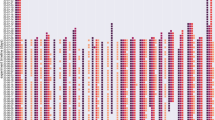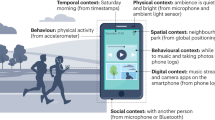Abstract
Microlevel activity time series (MLATS) data were gathered on hand contact activities of 38 children (1–6 years old) by videotaping in primarily outdoor residential environments. The videotape recordings were then translated into text files using a specialized software called VirtualTimingDevice™. Contact frequency (contacts/h), duration per contact (s/contact), and hourly contact duration (min/h) were summarized for outdoor hand contacts with 15 distinct object/surface categories (“Animal”, “Body”, “Clothes/Towels”, “Fabric”, “Floor”, “Food”, “Footwear”, “Metal”, “Non-dietary Water”, “Paper/Wrapper”, “Plastic”, “Rock/Brick”, “Toys”, “Vegetation/Grass”, and “Wood”) and two aggregate object/surface categories (“Non-dietary objects/surfaces” and “Total objects/surfaces”). For outdoor both hand contacts with “Total objects/surfaces”, contact frequencies ranged from 229.9 to 1517.7 contacts/h, median durations/contact ranged from <1 to 5 s, and hourly contact durations ranged from 42.6 to 102.2 m/h.
The data were analyzed for significant differences in hand contact activities as a function of (1) age, (2) location, (3) gender, and (4) hand. Significant differences (P⩽0.05) were found for all four factors analyzed. Hourly contact durations with “Non-dietary objects/surfaces” and “Total objects/surfaces” increased with age (P=0.01, rs=0.42 and P=0.005, rs=0.46, respectively), while contact frequencies and hourly contact durations with “Wood” decreased with age (P=0.02, rs=−0.38 and P=0.05, rs=−0.32, respectively). Location was found to affect contact frequencies and hourly contact durations with certain objects/surfaces. For example, contact frequencies and hourly contact durations with “Fabric” were higher indoors (P=0.02 for both), while contact frequencies and hourly contact durations with “Vegetation/Grass” were higher outdoors (P=0.02 and P=0.04, respectively). Girls had longer hourly contact durations with “Footwear” (P=0.02), “Non-dietary objects/surfaces” (P=0.03), and “Total objects/surfaces” (P=0.01) than boys. The right hand had longer hourly contact durations with objects that are often manipulated with the hand (e.g., “Toys” (P=0.0002)), while the left hand had longer hourly contact durations with passively touched objects/surfaces (e.g., “Clothes/Towels” (P=0.003) and “Floor” (P=0.04)).
This is a preview of subscription content, access via your institution
Access options
Subscribe to this journal
Receive 6 print issues and online access
$259.00 per year
only $43.17 per issue
Buy this article
- Purchase on Springer Link
- Instant access to full article PDF
Prices may be subject to local taxes which are calculated during checkout


Similar content being viewed by others
References
AuYeung W., Canales R.A., Beamer P., Ferguson A., and Leckie J.O. Young children's mouthing behavior: an observational study via videotaping in a primarily outdoor residential setting. J Children's Health 2004: 2 (3–4): 271–295.
Black K., Shalat S.L., Freeman N.C.G., Jimenez M., Donnelly K.C., and Calvin J.A. Children's mouthing and food-handling behavior in an agricultural community on the US/Mexico border. J Expos Anal Environ Epidemiol 2005: 15 (3): 244–251.
Canales R.A. The cumulative and aggregate simulation of exposure framework. Ph.D. Thesis Dissertation, Stanford University, 2004.
Ferguson A.C. Estimating percutaneous absorption using micro-level activity time series (MLATS). Ph.D. Thesis Dissertation, Stanford University, 2003.
Ferguson A.C., Canales R.A., Paloma B., AuYeung W., Key M., Munninghoff A., Lee K.T., Robertson A., and Leckie J.O. Collecting children's activity patterns using videotaping and video-translation. J Expos Anal Environ Epidemiol 2005 (advance online publication) October 12, 2005.
Freeman N.C.G., Hore P., Black K., Jimenez M., Sheldon L., Tulve N., and Lioy P.J. Contributions of children's activities to pesticide hand loadings following residential pesticide application. J Expos Anal Environ Epidemiol 2005: 15 (1): 81–88.
Freeman N.C.G., Jimenez M., Reed K.J., Gurunathan S., Edwards R.D., and Lioy P.J. Quantitative analysis of children's micro activity patterns: The Minnesota Children's Pesticide Exposure Study. J Expos Anal Environ Epidemiol 2001: 11 (6): 501–509.
Reed K.J., Jimenez M., Freeman N.C., and Lioy P.J. Quantification of children's hand and mouthing activities through a videotaping methodology. J Expos Anal Environ Epidemiol 1999: 9 (5): 513–520.
Rice J. Mathematical Statistics and Data Analysis, 2nd edn. Wadsworth, Belmont, CA, 1995.
Riley W.J., McKone T.E., and Cohen Hubal EA Estimating contaminant dose for intermittent dermal contact: Model development, testing, and application. Risk Anal 2004: 24 (1): 73–85.
Timmer S.G., Eccles J., and O'Brien K. How children use time. In: Juster F.T., and Stafford F.P. (Eds.). Times, Goods, and Well-Being. Survey Research Center, Institute for Social Research. Survey Research Center, Institute for Social Research, University of Michigan, Ann Arbor, MI, 1985.
Tulve N.D., Suggs J.C., McCurdy T., Cohen Hubal E.A., and Moya J. Frequency of mouthing behavior in young children. J Expos Anal Environ Epidemiol 2002: 12 (4): 259–264.
Zartarian V.G., Ferguson A.C., and Leckie J.O. Quantified dermal activity data from a four-child pilot field study. J Expos Anal Environ Epidemiol 1997a: 7 (4): 543–552.
Zartarian V.G., Ferguson A.C., Ong C.G., and Leckie J.O. Quantifying videotaped activity patterns: Video translation software and training methodologies. J Expos Anal Environ Epidemiol 1997b: 7 (4): 535–542.
Zartarian V.G., and Leckie J.O. Dermal exposure: the missing link. Environ Sci Technol 1998: 32 (5): 134A–137A.
Zartarian V.G., Ozkaynak H., Burke J.M., Zufall M.J., Rigas M.L., and Furtaw E.J. A modeling framework for estimating children's residential exposure and dose to chlorpyrifos via dermal residue contact and non-dietary ingestion. Environ Health Perspect 2000: 108 (6): 505–514.
Zartarian V.G. A physical-stochastic model for understanding dermal exposure to chemicals. Ph.D. Thesis Dissertation, Stanford University, 1996.
Acknowledgements
The authors specially thank Kelly Naylor, Nolan Cabrera, Sandy Robertson, Kevin Lee, Amy Munninghoff, Veronica Vieira, Jessica Ramirez, and Angela Lin for their invaluable help in collecting the data presented in this paper. This project was supported by EPA STAR grant #R82936201, ORETF Study #ORF018, USEPA Contract #QT-RT-99-001182, and UPS Foundation grant #2DDA103. This research has not been subject to federal peer and policy review and therefore does not necessarily reflect the views of the funding agencies. No official endorsement should be inferred.
Author information
Authors and Affiliations
Corresponding author
Rights and permissions
About this article
Cite this article
AuYeung, W., Canales, R., Beamer, P. et al. Young children's hand contact activities: An observational study via videotaping in primarily outdoor residential settings. J Expo Sci Environ Epidemiol 16, 434–446 (2006). https://doi.org/10.1038/sj.jes.7500480
Received:
Accepted:
Published:
Issue Date:
DOI: https://doi.org/10.1038/sj.jes.7500480
Keywords
This article is cited by
-
A Community-Based Health Risk Assessment Following the Gold King Mine Spill: Results from the Gold King Mine Spill Diné Exposure Project
Exposure and Health (2023)
-
Mouthing activity data for children age 3 to <6 years old and fraction of hand area mouthed for children age <6 years old in Taiwan
Journal of Exposure Science & Environmental Epidemiology (2018)
-
Mouthing activity data for children aged 7 to 35 months in Taiwan
Journal of Exposure Science & Environmental Epidemiology (2015)
-
Quantified outdoor micro-activity data for children aged 7–12-years old
Journal of Exposure Science & Environmental Epidemiology (2012)
-
Surface-to-food pesticide transfer as a function of moisture and fat content
Journal of Exposure Science & Environmental Epidemiology (2009)



